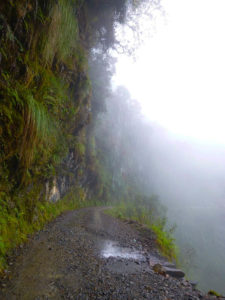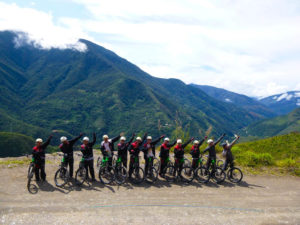The Death Road is, without a doubt, the most hyped up mountain biking route in the world. It’s been labeled as the “world’s most dangerous road”, and allegedly claimed 200 to 300 lives each year in the past. Documentaries have covered it. Every backpacker in South America speaks of it. Being an extremely narrow road, often only one car wide, means one mistake could throw you down a 600 metre cliff. If you’re feeling brave, do it.
Verdict: Definitely an adrenaline pumping ride. You’ll literally be on the edge. You’ll be on the highway to hell, being one meter and a stray rock away from falling over a 600 meter cliff. Do it with a goo tour company for a good time.
[yasr_multiset setid=0]



The Death Road is a road from La Paz to Coroico. The Inter-American Development Bank previously called it as the “world’s most dangerous road” and one estimate stated that around 200 to 300 travellers were killed every year on the road. This is a two-way road which is narrow (often only room one vehicle) next to a cliff with few guardrails. Unsurprisingly, a number of vehicles have fallen over the cliff in the past, and crosses at the side of the road are to commemorate these incidents.
Of course, the more dangerous something is, the more people would like to conquer it. Death Road biking tours have become more and more popular. Based on web sources, around 18 people have died biking the Death Road.
The day before the ride, my nerves started to kick in and I decided to do a bit more research. It may my anxiety even worse. On the one hand, I feel comforted that most motor traffic nowadays uses the new road, meaning that I wouldn’t have to bike against a lot of opposite traffic in a narrow road. On the other hand, I still see a number of articles where bikers die or get seriously hurt (and this was as recent as 2017!).
Then came the day, which started pretty ominously. One of the riders pulled out because he had ‘migraines’. Another suffered an injury in the early stretches of the route and decided to sit the rest of the route in the van, which followed all the bikes. Not being used to riding on gravel and bumpy roads, I was also knocked off my bike once.
The whole route was around 63km in total. The first twenty or so kilometres were a piece of cake. It was a warm up and smooth downhill ride on flat tarmac. No problem at all.
The most challenging part I’d say was the initial stretches of the Death Road. Although the road in the initial stretch was not the narrowest, it was difficult to suddenly adapt to riding on gravel and loose rocks. I crashed once (fortunately where the road was wide) because I didn’t keep enough momentum and lost balance when I hit a rock. I therefore had too pick up my speed a little as braking too much on gravel could cause my to skid and loose balance.
It also didn’t help that downhill bikers were required to ride on the outside of the road (i.e. near the cliff) and that visibility was low because of the fog. At times, I was riding at speed and was only a metre away from the edge. One loose rock could have sent me off balance and plunging down the cliff. I stayed focused and the road ahead, trying to follow the car tire marks (so that the route was less bumpy). Eventually, when I realized that there was little uphill traffic, I consciously decided to disobey traffic rules and biked on the inside of the road. Trust me, it never felt so good to disobey traffic rules.
After the initial stretch, I became more comfortable with my bike. A couple of stops later, we reached the next most challenging part of the route. The Devil’s Throat. This was the narrowest part of the Death Road, where the width is almost a single vehicle. On top of that, there is a section where there is waterfall at the side, making the road wet and slippery, and very uneven. Looking back at the videos, the Devil’s Throat was scary as fuck.
The rest of the route was more straight-forward as the road starts to widen up. The only challenge here is to avoid over-confidence and to respect the turns.
In conclusion, the Death Road is not as dangerous as it once was. There is now limited motor traffic on the road and more guardrails. More importantly, choose a repute tour operator, who will provide you with the appropriate guidance. I was fortunate that our guide (Rob) made this process very manageable for us. He made stops before every difficult section, highlighting where te potential bumps are, which turns to slow down on, and when to avoid over-confidence. He also provided mountain biking newbies like me with some coaching, such as braking gently with both brakes to avoid skidding (a hard brake would send you tumbling over the bike).


Additional information
| When to do it? | Best to do it in the dry season (i.e. from April to October). However, please note that weather can be unpredictable in the mountains. |
| How to book? | Book online or at the tour operator office. I booked with Gravity Bolivia, which is more expensive but probably the most reputed operator in La Paz. |
| How much does it cost? | The ride costs USD124. There is also a 50 Boliviano park fee. You will also need to arrange your own insurance or can purchase additional insurance with Gravity for around USD15. |
| How to get there? | Gravity Bolivia will pick you up at a meeting in La Paz. |
| How long does it take?
|
The tour starts at 7am with basic instructions. After around an hour ride to La Cumbre (the starting point), you will ride around 3 to 4 hours until you reach Yolosa (the end point). We departed Yolosa at around 6pm and were back in La Paz at around 8:30pm. |
| Is it difficult/safe?
|
To say it is completely safe is a lie. There have been around 18 deaths in the past and other accidents. However, if you follow a good tour operator and be sensible (i.e. don’t drink drive), you can stay safe.
In terms of difficulty, you don’t need to be a mountain biker, but will need to know how to ride a bike. In particular, you will need to be able to control the bike in bumpy conditions. The ride is mostly downhill, so fitness or stamina should not be an issue. |
| What to wear?
|
Bring a backpack and start off by wearing something warm as the starting point is around 4,700m high and is very windy. Towards the end point, it becomes very hot and you can take off your layers and put them in your backpack in the van during stops. Gravity will provide you with helmets and gloves. |
| Language | Guides will speak English and can also speak in Spanish. |